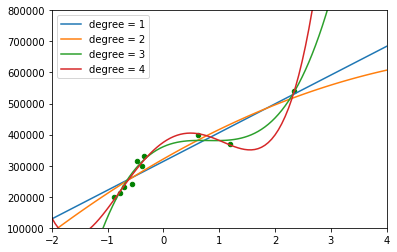首先,导入一组数据,代码如下:
import numpy as np import matplotlib.pyplot as plt x, y = [], [] for sample in open("../_Data/prices.txt", "r"): _x, _y = sample.split(",") x.append(float(_x)) y.append(float(_y)) x, y = np.array(x), np.array(y) x = (x - x.mean()) / x.std() plt.figure() plt.scatter(x, y, c="g", s=6) plt.show()
其中对导入数据进行处理:
x.mean()是平均值,x.std()是标准差
def get_model(deg): return lambda input_x=x0: np.polyval(np.polyfit(x, y, deg), input_x) # 根据参数n、输入的x、y返回相对应的损失 def get_cost(deg, input_x, input_y): return 0.5 * ((get_model(deg)(input_x) - input_y) ** 2).sum() test_set = (1,2,3,4) for d in test_set: # 输出相应的损失 print(get_cost(d, x, y)) # 画出相应的图像 plt.scatter(x, y, c="g", s=20) for d in test_set: plt.plot(x0, get_model(d)(), label="degree = {}".format(d)) # 将横轴、纵轴的范围分别限制在(-2,4)、(〖10〗^5,8×〖10〗^5) plt.xlim(-2, 4) plt.ylim(1e5, 8e5) # 调用legend方法使曲线对应的label正确显示 plt.legend() plt.show()
应用如下模型对多项式进行拟合:

以下是拟合的结果,从图像中能得出,n取3时效果最好




